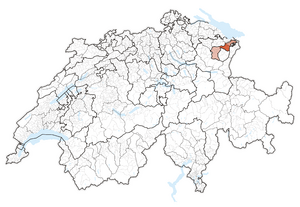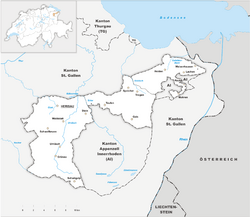Appenzell Ausserrhoden facts for kids
Quick facts for kids
Kanton Appenzell-Ausserrhoden
|
||
|---|---|---|
|
||
 |
||
| Capital | Herisau (administrative) Trogen (judicial) |
|
| Subdivisions | 20 municipalities | |
| Area | ||
| • Total | 243 km2 (94 sq mi) | |
| Area rank | 23rd | |
| Population
(2006)
|
||
| • Total | 52,509 | |
| • Rank | 21st | |
| • Density | 216.1/km2 (559.7/sq mi) | |
| Highest point | 2,502 m (8,209 ft) - Säntis | |
| Joined | 1513 | |
| Abbreviation | AR | |
| Languages | German | |
| Website | AR.ch | |
Appenzell Ausserrhoden is a canton (like a state) in Switzerland. It is located in the northeast part of Switzerland. It shares borders with the canton of St. Gallen and Appenzell Innerrhoden. Herisau is its administrative capital, and Trogen is its judicial capital.
Contents
History of Appenzell Ausserrhoden
Early Settlements and Name
People first started living in the Appenzell area around the 7th and 8th centuries. They settled along the Glatt river. The town of Herisau was first mentioned in the year 907. The name "Appenzell" comes from "abbatis cella," which means "abbot's cell" or "monk's cell."
Important Battles and Joining Switzerland
The canton was home to some important battles. These included the Battle of Vögelinsegg in 1403 and the Battle at the Stoss in 1405. In 1513, Appenzell officially joined the Swiss confederation. It was the 13th canton to become a part of Switzerland.
Religious Division
In 1597, the original canton of Appenzell split into two parts. This happened because of religious differences. Appenzell Ausserrhoden became the Protestant part. The other half, Appenzell Innerrhoden, remained Catholic.
Textile Industry and Economy
From the 16th century, the production of linen slowly grew in the canton. Later, bigger textile businesses started, focusing on weaving and embroidery. However, the textile industry faced big problems between 1920 and 1939.
Modern Developments and Rights
In 1834, Appenzell Ausserrhoden adopted its first constitution. This constitution was updated in 1876 and again in 1908. Building many railway lines between 1875 and 1913 helped local businesses. The population also grew, reaching its highest point of 57,973 people in 1910.
In 1934, Johannes Baumann became the first person from Appenzell Ausserrhoden to be a federal councilor. This is a very important government position in Switzerland. Women's right to vote was introduced locally in 1972. However, women could only vote in canton-wide elections starting in 1989. In 1994, two women were elected into the canton's government for the first time. The traditional open assembly, called the Landsgemeinde, was stopped in 1997.
Municipalities
Appenzell Ausserrhoden is divided into 20 smaller areas called municipalities. These are like local towns or districts.
Aargau · Appenzell Innerrhoden · Appenzell Ausserrhoden · Basel-Stadt · Basel-Landschaft · Bern · Fribourg · Geneva · Glarus · Graubünden · Jura · Lucerne · Neuchâtel · Nidwalden · Obwalden · Schaffhausen · Schwyz · Solothurn · St. Gallen · Thurgau · Ticino · Uri · Valais · Vaud · Zug · Zürich
Images for kids
See also
 In Spanish: Cantón de Appenzell Rodas Exteriores para niños
In Spanish: Cantón de Appenzell Rodas Exteriores para niños




